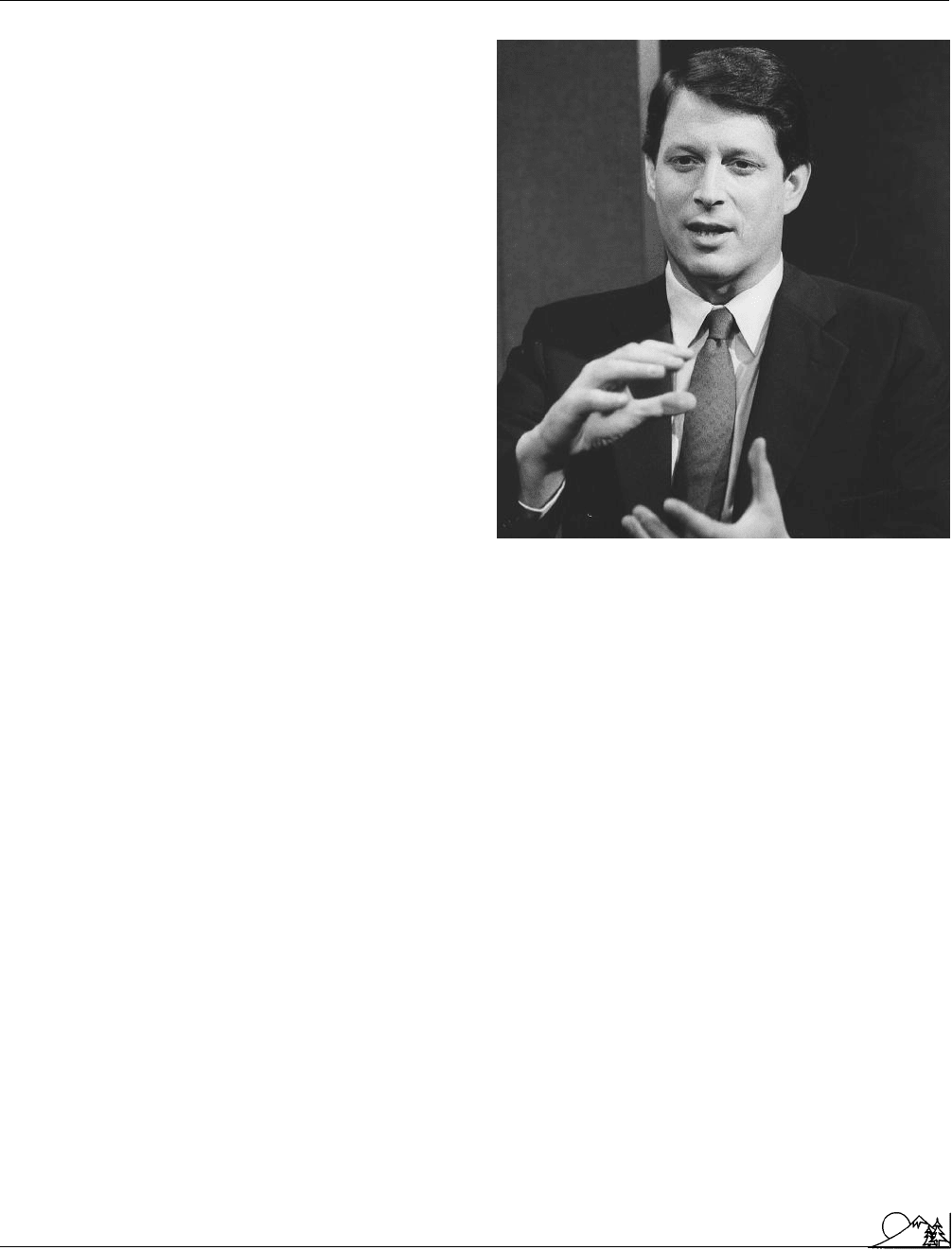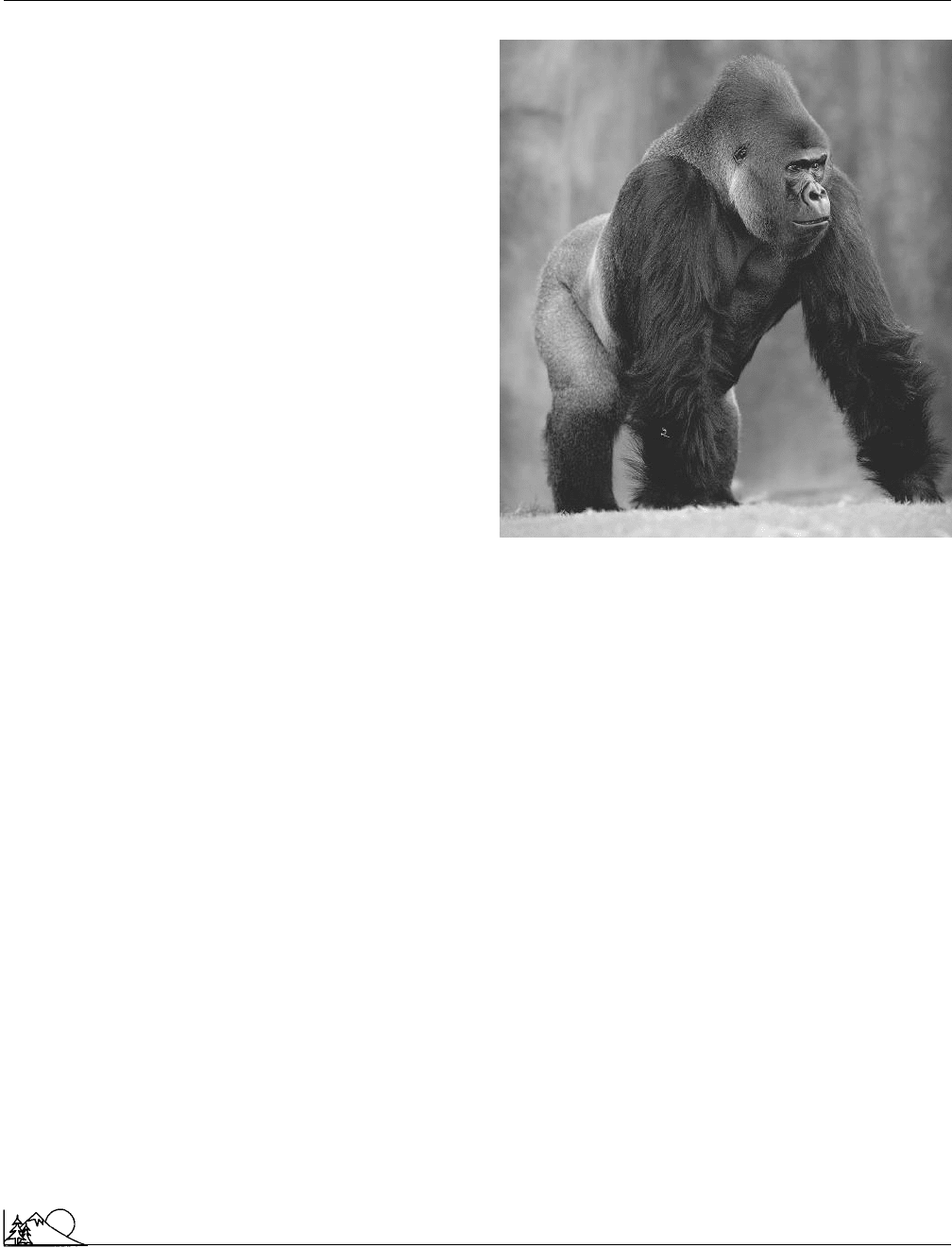Environmental Encyclopedia
Подождите немного. Документ загружается.


Environmental Encyclopedia 3
Golf courses
be done particularly effectively in the brushy and forested
areas between the holes and their approaches. The habitat
quality in these less-intensively managed areas can also be
enhanced by providing nesting boxes and brush piles for use
by birds and small mammals, and by other management
practices known to favor
wildlife
. Habitat quality is also
improved by planting native species of plants wherever it is
feasible to do so.
In addition to land appropriation, some of the manage-
ment practices used on golf courses carry the risk of causing
local environmental damage. This is particularly the case of
putting greens, which are intensively managed to maintain
an extremely even and consistent lawn surface.
For example, to maintain a
monoculture
of desired
species of grasses on putting greens and lawns, intensive
management practices must be used. These include frequent
mowing,
fertilizer
application, and the use of a variety of
pesticidal
chemicals
to deal with various pests affecting the
turfgrass. This may involve the application of such herbicides
as Roundup (glyphosate),
2,4-D
, MCPP, or Dicamba to deal
with undesirable weeds.
Herbicide
application is particularly
necessary when putting greens and lawns are being first
established. Afterward their use can be greatly reduced by
only using spot-applications directly onto turf-grass weeds.
Similarly, fungicides might be used to combat infestations
of turf-grass disease
fungi
, such as the fusarium blight (Fu-
sarium culmorum), take-all patch (Gaeumannomyces graminis),
and rhizoctonia blight (Rhizoctonia solani).
Infestations by turf-damaging insects may also be a
problem, which may be dealt with by one or more insecticide
applications. Some important insect pests of golf-course turf-
grasses include the Japanese beetle (Popillia japonica), chafer
beetles (Cyclocephala spp.), June beetles (Phyllophaga spp.),
and armyworm beetle (Pseudaletia unipuncta). Similarly, ro-
denticides may be needed to get rid of moles (Scalopus aquat-
icus) and their burrows.
Golf courses can also be a major user of water, mostly
for the purposes of
irrigation
in dry climates or during
droughty periods. This can be an important problem in
semi-arid regions, such as much of the southwestern U.S.,
where water is a scare and valuable commodity with many
competing users. To some degree, water use can be decreased
by ensuring that irrigation is only practiced when necessary,
and only in specific places where it is needed, rather than
according to a fixed schedule and in a broadcast manner. In
some climatic areas, nature-scaping and other low-mainte-
nance practices can be used over extensive areas of golf
courses. This can result in intensive irrigation only being
practiced in key areas, such as putting greens, and to a lesser
degree fairways and horticultural lawns.
Many golf courses have ponds and lakes embedded in
their spatial design. If not carefully managed, these
647
waterbodies can become severely polluted by nutrients, pesti-
cides, and eroded materials. However, if care is taken with
golf-course management practices, their ponds and lakes can
sustain healthy ecosystems and provide refuge habitat for
local native plants and animals.
Increasingly, golf-course managers and industry asso-
ciations are attempting to find ways to support their sport
while not causing an unacceptable amount of environmental
damage. One of the most important initiatives of this kind
is the Audubon Cooperative Sanctuary Program for Golf
Courses, run by the Audubon International, a private conser-
vation organization. Since 1991, this program has been pro-
viding
environmental education
and conservation advice
to golf-course managers and designers. By 2002, member-
ship in this Audubon program had grown to more than
2,300 courses in North America and elsewhere in the world.
The Audubon Cooperative Sanctuary Program for
Golf Courses provides advice to help planners and managers
with: (a) environmental planning; (b) wildlife and habitat
management; (c) chemical use reduction and safety; (d)
water conservation
; and (e) outreach and education about
environmentally appropriate management practices. If a golf
course completes recommended projects in all of the compo-
nents of the program, it receives recognition as a Certified
Audubon Cooperative Sanctuary. This allows the golf course
to claim that it is conducting its affairs in a certifiably “green”
manner. This results in tangible environmental benefits of
various kinds, while being a source of pride of accomplish-
ment for employees and managers, and providing a potential
marketing benefit to a clientele of well-informed consumers.
There are many specific examples of environmental
benefits that have resulted from golf courses engaged in
the Audubon Cooperative Sanctuary Program. For instance,
seven golf courses in Arizona and Washington have allowed
the installation of 150 artificial nesting burrows for bur-
rowing owls (Athene cunicularia), an endangered species, on
suitable habitat on their land. In 2000, Audubon Interna-
tional conducted a survey of cooperating golf courses, and the
results were rather impressive. About 78% of the respondents
reported that they had decreased the total amount of turf-
grass area on their property; 73% had taken steps to increase
the amount of wildlife habitat; 45% were engaged in an
ecosystem restoration project; 90% were attempting to use
native plants in their horticulture; and 85% had decreased
their use of pesticides and 91% had switched to lower-
toxicity chemicals. Just as important, about half of the re-
spondents believed that there had been an improvement in
the playing quality of their golf course and in the satisfaction
of both employees and their client golfers. Moreover, none
of the respondents believed that any of these values had been
degraded as a result of adopting the management practices
advised by the Audubon International program.

Environmental Encyclopedia 3
Good wood
These are all highly positive indicators. They suggest
that the growing and extremely popular sport of golf can,
within limits, potentially be practiced in ways that do not
cause unacceptable levels of environmental and ecological
damage.
[Bill Freedman Ph.D.]
R
ESOURCES
B
OOKS
Balogh, J. C., and W. J. Walker, eds. Golf Course Management and Construc-
tion: Environmental Issues. Leeds, UK: Lewis Publishers, 1992.
Gillihan, S. W. Bird Conservation on Golf Courses: A Design and Management
Manual. Ann Arbor, MI: Ann Arbor Press, 1992.
Sachs, P. D., and R.T. Luff. Ecological Golf Course Management. Ann Arbor,
MI: Ann Arbor Press, 2002.
O
THER
“Audubon Cooperative Sanctuary Program for Golf.” Audubon Interna-
tional. 2002 [cited July 2002]. –http://www.audubonintl.org/programs/acss/
golf.htm>.
United States Golf Association. [cited July 2002]. <http://www.usga.org>.
O
RGANIZATIONS
United States Golf Association, P.O. Box 708, Far Hills, N.J. USA 07931-
0708, Fax: 908-781-1735, Email: usga.org, http://www.usga.org/
Good wood
Good wood, or smart wood, is a term certifying that the
wood is harvested from a forest operating under environmen-
tally sound and sustainable practices. A “certified wood”
label indicates to consumers that the wood they purchase
comes from a forest operating within specific guidelines
designed to ensure future use of the forest. A well-managed
forestry operation takes into account the overall health of the
forest and its ecosystems, the use of the forest by indigenous
people and cultures, and the economic influences the forest
has on local communities. Certification of wood allows the
wood to be traced from harvest through processing to the
final product (i.e., raw wood or an item made from wood)
in an attempt to reduce uncontrollable
deforestation
, while
meeting the demand for wood and wood products by con-
sumers around the world.
Public concern regarding the disappearance of tropical
forests initially spurred efforts to reduce the destruction of
vast acres of rainforests by identifying environmentally re-
sponsible forestry operations and encouraging such practices
by paying foresters higher prices. Certification, however, is
not limited to tropical forests. All forest types—tropical,
temperate, and boreal (those located in northern climes)—
from all countries may apply for certification. Plantations
(stands of timber that have been planted for the purpose of
logging
or that have been altered so that they no longer
648
support the ecosystems of a natural forest) may also apply
for certification.
Certification of forests and forest owners and managers
is not required. Rather, the process is entirely voluntary.
Several organizations currently assess forests and
forest
management
operations to determine whether they meet
the established guidelines of a well-managed, sustainable
forest. The Forest Stewardship Council (FSC), founded in
1993, is an organization of international members with envi-
ronmental, forestry, and socioeconomic backgrounds that
monitors these organizations and verifies that the certifica-
tion they issue is legitimate.
A set of 10 guiding principles known as Principles and
Criteria (P&C) were established by the FSC for certifying
organizations to utilize when evaluating forest management
operations. The P&C address a wide range of issues, includ-
ing compliance with local, national, and international laws
and treaties; review of the forest operation’s management
plans; the religious or cultural significance of the forest to
the indigenous inhabitants; maintenance of the rights of the
indigenous people to use the land; provision of jobs for
nearby communities; the presence of threatened or
endan-
gered species
; control of excessive
erosion
when building
roads into the forest; reduction of the potential for lost
soil
fertility as a result of harvesting; protection against the
invasion of non-native
species
;
pest
management that limits
the use of certain chemical types and of genetically altered
organisms; and protection of forests when deemed necessary
(for example, a forest that protects a
watershed
or that
contains threatened and/or endangered species).
Guarding against illegal harvesting is a major hurdle
for those forest managers working to operate within the
established regulations for certification. Forest devastation
occurs not only from harvesting timber for wood sales but
when forests are clear cut to make way for cattle crazing or
farming, or to provide a fuel source for local inhabitants.
Illegal harvesting often occurs in developing countries where
enforcement against such activities is limited (for example,
the majority of the trees harvested in Indonesia are done so
illegally).
Critics argue against the worthiness of managing for-
ests, suggesting that the logging of select trees from a forest
should be allowed and that once completed, the remaining
forest should be placed off limits to future logging. Neverthe-
less, certified wood products are in the market place; large
wood and wood product suppliers are offering certified wood
and wood products to their consumers. In 2001 the Forest
Leadership Forum (a group of environmentalists, forest in-
dustry representatives, and retailers) met to identify how
wood retailers can promote sustainable forests. It is hoped
that consumer demand for good wood will drive up the
number of forests participating in the certification program,

Environmental Encyclopedia 3
Jane Goodall
thereby reducing the rate of irresponsible deforestation of
the world’s forests.
[Monica Anderson]
R
ESOURCES
B
OOKS
Bass, Stephen, et al. Certification’s Impact on Forests, Stakeholders and Supply
Chains. London: IIED, 2001.
O
RGANIZATIONS
Forest Stewardship Council United States, 1155 30th Street, NW, Suite
300, Washington, DC USA 20007 (202) 342 0413, Fax: (202) 342 6589,
Email: info@foreststewardship.org, <http://www.fscus.org<
Jane Goodall (1934 – )
English primatologist and ethnologist
Jane Goodall is known worldwide for her studies of the
chimpanzees
of the Gombe Stream Reserve in Tanzania,
Africa. She is well respected within the scientific community
for her ground-breaking field studies and is credited with
the first recorded observation of chimps eating meat and
using and making tools. Because of Goodall’s discoveries,
scientists have been forced to redefine the characteristics
once considered as solely human traits. Goodall is now lead-
ing efforts to ensure that animals are treated humanely both
in their wild habitats and in captivity.
Goodall was born in London, England, on April 3,
1934, to Mortimer Herbert Goodall, a businessperson and
motor-racing enthusiast, and the former Margaret Myfanwe
Joseph, who wrote novels under the name Vanne Morris
Goodall. Along with her sister, Judy, Goodall was reared in
London and Bournemouth, England. Her fascination with
animal behavior began in early childhood. In her leisure
time, she observed native birds and animals, making exten-
sive notes and sketches, and read widely in the literature of
zoology and ethnology. From an early age, she dreamed of
traveling to Africa to observe exotic animals in their natural
habitats.
Goodall attended the Uplands private school, receiving
her school certificate in 1950 and a higher certificate in
1952. At age eighteen she left school and found employment
as a secretary at Oxford University. In her spare time, she
worked at a London-based documentary film company to
finance a long-anticipated trip to Africa. At the invitation
of a childhood friend, she visited South Kinangop, Kenya.
Through other friends, she soon met the famed anthropolo-
gist Louis Leakey, then curator of the Coryndon Museum
in Nairobi. Leakey hired her as a secretary and invited her
to participate in an anthropological dig at the now famous
Olduvai Gorge, a site rich in fossilized prehistoric remains
of early ancestors of humans. In addition, Goodall was sent
649
to study the vervet monkey, which lives on an island in Lake
Victoria.
Leakey believed that a long-term study of the behavior
of higher primates would yield important evolutionary infor-
mation. He had a particular interest in the chimpanzee, the
second most intelligent primate. Few studies of chimpanzees
had been successful; either the size of the safari frightened
the chimps, producing unnatural behaviors, or the observers
spent too little time in the field to gain comprehensive
knowledge. Leakey believed that Goodall had the proper
temperament to endure long-term isolation in the wild. At
his prompting, she agreed to attempt such a study. Many
experts objected to Leakey’s selection of Goodall because
she had no formal scientific education and lacked even a
general college degree.
While Leakey searched for financial support for the
proposed Gombe Reserve project, Goodall returned to En-
gland to work on an animal documentary for Granada Tele-
vision. On July 16, 1960, accompanied by her mother and
an African cook, she returned to Africa and established a
camp on the shore of Lake Tanganyika in the Gombe Stream
Reserve. Her first attempts to observe closely a group of
chimpanzees failed; she could get no nearer than 500 yd
(457 m) before the chimps fled. After finding another suit-
able group of chimpanzees to follow, she established a non-
threatening pattern of observation, appearing at the same
time every morning on the high ground near a feeding area
along the Kakaombe Stream valley. The chimpanzees soon
tolerated her presence and, within a year, allowed her to
move as close as 30 ft (9 m) to their feeding area. After two
years of seeing her every day, they showed no fear and often
came to her in search of bananas.
Goodall used her newfound acceptance to establish
what she termed the “banana club,” a daily systematic feeding
method she used to gain trust and to obtain a more thorough
understanding of everyday chimpanzee behavior. Using this
method, she became closely acquainted with more than half
of the reserve’s one hundred or more chimpanzees. She
imitated their behaviors, spent time in the trees, and ate
their foods. By remaining in almost constant contact with the
chimps, she discovered a number of previously unobserved
behaviors. She noted that chimps have a complex social
system, complete with ritualized behaviors and primitive but
discernible communication methods, including a primitive
“language” system containing more than twenty individual
sounds. She is credited with making the first recorded obser-
vations of chimpanzees eating meat and using and making
tools. Tool making was previously thought to be an exclu-
sively human trait, used, until her discovery, to distinguish
man from animal. She also noted that chimpanzees throw
stones as weapons, use touch and embraces to comfort one
another, and develop long-term familial bonds. The male

Environmental Encyclopedia 3
Jane Goodall
plays no active role in family life but is part of the group’s
social
stratification
. The chimpanzee “caste” system places
the dominant males at the top. The lower castes often act
obsequiously in their presence, trying to ingratiate them-
selves to avoid possible harm. The male’s rank is often related
to the intensity of his entrance performance at feedings and
other gatherings.
Ethologists had long believed that chimps were exclu-
sively vegetarian. Goodall witnessed chimps stalking, killing,
and eating large insects, birds, and some bigger animals,
including baby baboons and bushbacks (small antelopes). On
one occasion, she recorded acts of cannibalism. In another
instance, she observed chimps inserting blades of grass or
leaves into termite hills to lure worker or soldier termites
onto the blade. Sometimes, in true toolmaker fashion, they
modified the grass to achieve a better fit. Then they used
the grass as a long-handled spoon to eat the termites.
In 1962 Baron Hugo van Lawick, a Dutch
wildlife
photographer, was sent to Africa by the National Geographic
Society to film Goodall at work. The assignment ran longer
than anticipated; Goodall and van Lawick were married on
March 28, 1964. Their European honeymoon marked one
of the rare occasions on which Goodall was absent from
Gombe Stream. Her other trips abroad were necessary to
fulfill residency requirements at Cambridge University,
where she received a Ph.D. in ethnology in 1965, becoming
only the eighth person in the university’s long history who
was allowed to pursue a Ph.D. without first earning a bacca-
laureate degree. Her doctoral thesis, “Behavior of the Free-
Ranging Chimpanzee,” detailed her first five years of study
at the Gombe Reserve.
Van Lawick’s film, Miss Goodall and the Wild Chim-
panzees, was first broadcast on American television on De-
cember 22, 1965. The film introduced the shy, attractive,
unimposing yet determined Goodall to a wide audience.
Goodall, van Lawick (along with their son, Hugo, born in
1967), and the chimpanzees soon became a staple of Ameri-
can and British public television. Through these programs,
Goodall challenged scientists to redefine the long-held “dif-
ferences” between humans and other primates.
Goodall’s fieldwork led to the publication of numerous
articles and five major books. She was known and respected
first in scientific circles and, through the media, became a
minor celebrity. In the Shadow of Man, her first major text,
appeared in 1971. The book, essentially a field study of
chimpanzees, effectively bridged the gap between scientific
treatise and popular entertainment. Her vivid prose brought
the chimps to life, although her tendency to attribute human
behaviors and names to chimpanzees struck some critics
being as manipulative. Her writings reveal an animal world
of social drama, comedy, and tragedy where distinct and
varied personalities interact and sometimes clash.
650
From 1970 to 1975 Goodall held a visiting professor-
ship in psychiatry at Stanford University. In 1973 she was
appointed honorary visiting professor of Zoology at the Uni-
versity of Dar es Salaam in Tanzania, a position she still
holds. Her marriage to van Lawick over, she wed Derek
Bryceson, a former member of Parliament, in 1973. He has
since died. Until recently, Goodall’s life has revolved around
Gombe Stream. But after attending a 1986 conference in
Chicago that focused on the ethical treatment of chimpan-
zees, she began directing her energies more toward educating
the public about the wild chimpanzee’s endangered
habitat
and about the unethical treatment of chimpanzees that are
used for scientific research.
To preserve the wild chimpanzee’s
environment
,
Goodall encourages African nations to develop nature-
friendly tourism programs, a measure that makes wildlife
into a profitable resource. She actively works with business
and local governments to promote ecological responsibility.
Her efforts on behalf of captive chimpanzees have taken her
around the world on a number of lecture tours. She outlined
her position strongly in her 1990 book Through a Window:
“The more we learn of the true nature of non-human ani-
mals, especially those with complex brains and corresponding
complex social behaviour, the more ethical concerns are
raised regarding their use in the service of man-whether this
be in entertainment, as ’pets,’ for food, in research labora-
tories or any of the other uses to which we subject them.
This concern is sharpened when the usage in question leads
to intense physical or mental suffering-as is so often true
with regard to vivisection.”
Goodall’s stance is that scientists must try harder to
find alternatives to the use of animals in research. She has
openly declared her opposition to militant
animal rights
groups who engage in violent or destructive demonstrations.
Extremists on both sides of the issue, she believes, polarize
thinking and make constructive dialogue nearly impossible.
While she is reluctantly resigned to the continuation of
animal research, she feels that young scientists must be edu-
cated to treat animals more compassionately. “By and large,”
she has written, “students are taught that it is ethically ac-
ceptable to perpetrate, in the name of science, what, from
the point of view of animals, would certainly qualify as
torture.”
Goodall’s efforts to educate people about the ethical
treatment of animals extends to young children as well.
Her 1989 book, The Chimpanzee Family Book, was written
specifically for children, to convey a new, more humane
view of wildlife. The book received the 1989 Unicef/Unesco
Children’s Book-of-the-Year award, and Goodall used the
prize money to have the text translated into Swahili. It has
been distributed throughout Tanzania, Uganda, and Bu-

Environmental Encyclopedia 3
Albert Gore Jr.
Jane Goodall. (The Library of Congress.)
rundi to educate children who live in or near areas populated
by chimpanzees. A French version has also been distributed
in Burundi and Congo.
In recognition of her achievements, Goodall has re-
ceived numerous honors and awards, including the Gold
Medal of
Conservation
from the San Diego Zoological
Society in 1974, the J. Paul Getty Wildlife Conservation
Prize in 1984, the Schweitzer Medal of the
Animal Welfare
Institute
in 1987, the National Geographic Society Centen-
nial Award in 1988, and the Kyoto Prize in Basic Sciences
in 1990. In 1995, Goodall was presented with a CBE (Com-
mander of the British Empire) from Queen Elizabeth II.
Many of Goodall’s endeavors are conducted under the aus-
pices of the Jane Goodall Institute for Wildlife Research,
Education, and Conservation, a nonprofit organization lo-
cated in Ridgefield, Connecticut. In April of 2002, it was
revealed that Goodall was chosen to be a United Nations
Messenger of Peace.
[Tom Crawford]
R
ESOURCES
B
OOKS
Green, T. The Restless Spirit: Profiles in Adventure. Walker, 1970.
Goodall, J. Jane Goodall’s Animal World: Chimpanzees. Macmillan, 1989.
651
———. Through a Window: My Thirty Years with the Chimpanzees of Gombe.
Houghton, 1990.
Montgomery, S.Walking with the Great Apes: Jane Goodall, Dian Fossey,
Birute Galdikas. Houghton Mifflin, 1991.
Smith, W. “The Wildlife of Jane Goodall.” USAir, February 1991, 42–47.
Gopherus agassizii
see
Desert tortoise
Albert Gore Jr. (1948 – )
American former U.S. representative, senator and vice
president of the United States
Albert Gore, Jr. was born and raised in Washington, D.C.,
where his father was a well-known and widely respected
representative and later senator from Tennessee. Gore at-
tended St. Alban’s Episcopal School for Boys, where he
excelled both academically and athletically. He later went
to Harvard, earning a bachelor’s degree in government. After
graduation he enlisted in the army, serving as a reporter in
Vietnam in a war he was opposed to. After completing his
tour of duty, in 1974 Gore entered the law school at Vander-
bilt University. Following in his father’s footsteps, Gore
ran for Congress, was elected, and served five terms before
running for and winning a Senate seat in 1984. He served in
the Senate until 1992, when then-governor and Democratic
presidential candidate Bill Clinton selected him as his vice
presidential running-mate. After winning the 1992 election
Vice President Gore became the Clinton administration’s
chief environmental advisor. He was also largely responsible
for President Clinton’s selection of
Carol Browner
as head
of the
Environmental Protection Agency
(EPA) and Bruce
Babbit as Secretary of the Interior.
A self-described “raging moderate,” Gore for more
than two decades championed environmental causes and
drafted and sponsored environmental legislation in the Sen-
ate. He was one of two U.S. senators to attend and take an
active part in the 1992 U.N.-sponsored Rio Summit on the
environment
, and after he became vice president in 1993,
he took a leading role in shaping the Clinton administration’s
environmental agenda. As vice president, Gore’s ability to
shape that agenda was perhaps somewhat limited. At the
close of Clinton’s first term, most environmental organiza-
tions rated his administration’s record on environmental
matters as mixed, at best. Yet clearly environmental groups
had more access to the White House than they had ever
had before. And in his second term, Gore was thought to
be responsible for salvaging the 1997 Kyoto agreement on
climate
change when he flew to Japan as negotiations were
falling apart and personally represented a new American
position.

Environmental Encyclopedia 3
Albert Gore Jr.
Gore’s most notable contribution to the environmental
movement might be as an author. With a wealth of statistical
and scientific evidence, Gore’s 1992 book Earth in the Bal-
ance makes the case that careless development and growth
have damaged the natural environment; but better policies
and regulations will supply incentives for more environmen-
tally responsible actions by individuals and corporations. For
example, a so-called
carbon tax
could provide financial
incentives for developing new, nonpolluting energy sources
such as solar and wind power. Corporations could also be
given tax credits for using these new sources. By structuring
a system of incentives that favors the protection and restora-
tion of the natural environment, government at the local,
national, and (through the United Nations) international
levels can restore the balance between satisfying human
needs and protecting the earth’s environment. But restoring
this balance, Gore maintained in his book, requires more
than public policy and legislation; it requires changes in basic
beliefs and attitudes toward
nature
and all living creatures.
More specifically, environmental protection and restoration
requires a willingness on the part of individuals to accept
responsibility for their actions (or inaction). At the individual
level, environmental protection means living, working,
eating, and recreating responsibly, with an eye to one’s effects
on the natural and social environment, now and in the future
in which our children and their children will survive.
Despite the strong stances Gore articulated in Earth
in the Balance, his achievements as vice president under
Clinton were more moderate. His former staffer Carol
Browner headed the EPA, and she prevailed in promoting
several major pieces of environmental legislation. But she
had to withstand concerted attacks on her and her office by
the Republican majority in the House and Senate after 1994.
Gore had managed to save the Kyoto treaty on climate
change by his personal efforts in 1997, but the Clinton
administration never committed to specific actions to cut
carbon-dioxide emissions. In August 1998 Gore met with
the leaders of several environmental groups and explained
to them that he had no political backing for advocating
controversial actions like limiting
pollution
from coal-burn-
ing
power plants
. When he ran for president in 2000, the
environment was not a strong feature in his campaign,
though this was an area where he had sharp differences with
his opponent, George W. Bush. In the last months of the
campaign, Gore found himself defending his record on the
environment against Green Party candidate
Ralph Nader
.
Though Gore had the backing of the
Sierra Club
and other
major environmental groups, Nader accused Gore of “eight
years of principles betrayed and promises broken.” In the
end Gore lost the election to Bush, who quickly reversed
Clinton administration environmental policies such as new
652
Albert Gore, Jr. (Corbis-Bettmann. Reproduced by per-
mission.)
standards on drinking water safety, and refused to endorse
the Kyoto climate change treaty.
After losing the election, Gore began lecturing at Fisk
University in Nashville, at UCLA, and at the School of
Journalism at Columbia University. Out of office, he re-
mained for the most part out of the public eye. But he did
speak at Vanderbilt University on
Earth Day
in 2002,
roundly criticizing George W. Bush for his
environmental
policy
. Gore noted that some of his more extreme environ-
mental stances, such as calling for new technology to replace
the internal
combustion
engine, were now being considered
even by Republican lawmakers. In mid-2002, Gore would
not commit to another run for the presidency. But it did
seem that he stood by his earlier ideas, and would continue
to identify himself with the environmental movement.
[Terence Ball]
R
ESOURCES
B
OOKS
Gore Jr., Albert. Earth in the Balance. Boston: Houghton Mifflin, 1992.
P
ERIODICALS
Barro, Robert J. “Gore’s ’Reckless and Offensive’ Passion for the Environ-
ment.” Business Week, November 6, 2000, 32.

Environmental Encyclopedia 3
Gorillas
Berke, Richard L. “Lieberman Has One Eye on ’04 Run, the Other, Quite
Expectably, on Gore.” New York Times, May 2, 2002, A25.
Branegan, Jay, and Dick Thompson. “Is Al Gore a Hero or a Traitor?”
Time , April 26, 1999, 66.
“How Green Is Al Gore?” Economist (April 22, 2000): 30.
Jehl, Douglas. “On a Favorite Issue, Gore Finds Himself on a 2-Front
Defense.” New York Times, November 3, 2000, A28.
Seelye, Katherine Q. “Gore, on Earth Day, Says Bush Policies Help Pollut-
ers.” New York Times, April 23, 2002, A16.
Gorillas
Gorillas (Gorilla gorilla) inhabit the forests of Central Africa
and are the largest and most powerful of all primates. Adult
males stand 6 ft (1.8 m) upright (an unnatural position for
a gorilla) and weigh up to 450 lb (200 kg), while females
are much smaller. Gorillas live to about 44 years and mature
males (those usually over 13 years), or silverbacks, are marked
by a band of silver-gray hair on their backs.
Gorillas live in small family groups of several females
and their young, led by a dominant silverback male. The
females comprise a harem for the silverback, who holds the
sole mating rights in the troop. Like humans, female gorillas
produce one infant after a gestation period of nine months.
The large size and great strength of the silverback are advan-
tages in competing with other males for leadership of the
group and in defending the group against outside threats.
During the day these ground-living apes move slowly
through the forest, selecting
species
of leaves, fruit, and
stems from the surrounding vegetation. Their home range
is about 9–14 mi
2
(25–40 km
2
). At night the family group
sleeps in trees, resting on platform nests that they make
from branches; silverbacks usually sleep at the foot of the tree.
Gorillas belong to the family Pongidae (which includes
chimpanzees
Pan], orangutans [Pongo pygmaeus], and
gib-
bons
[genus Hylobates). Together with chimpanzees, gorillas
are the animal species most closely related to man. Like
most megavertebrates, gorilla numbers are declining rapidly
and only about 40,000 remain in the wild. There are three
subspecies, the western lowland gorilla (G. g. gorilla), the
eastern lowland gorilla (G. g. graueri), and the mountain
gorilla (G. g. beringei). The rusty-gray western lowland goril-
las are found in Nigeria, Cameroon, Equatorial Guinea,
Gabon, Congo, Angola, Central African Republic, and Zaire
(now Democratic Republic of the Congo [DRC]). The
black-haired eastern lowland gorillas are found in eastern
DRC.
Deforestation
and
hunting
now threaten lowland
gorillas throughout their range.
The mountain gorilla has been intensely studied in the
field, notably by George Schaller and Dian Fossey, upon
whose life the film Gorillas in the Mist is based. This endan-
gered subspecies is found in the misty mountains of eastern
653
A silverback male gorilla. (Photograph by Jerry L.
Ferrara. Photo Researchers Inc. Reproduced by per-
mission.)
Zaire, Rwanda, and Uganda at altitudes of up to 9,000 ft
(3,000 m) and in the Impenetrable Forest in southwest
Uganda. Field research has shown these powerful primates to
be intelligent, peaceful and shy,and of little danger to humans.
Other than humans, gorillas have no real predators,
although leopards will occasionally take young apes. Hunt-
ing,
poaching
(a mountain gorilla is worth $150,000), and
habitat
loss are causing gorilla populations to decline. The
shrinking forest refuge of these great apes is being progres-
sively felled in order to accommodate the ever-expanding
human population. Mountain gorillas are somewhat safe-
guarded in the Virunga Volcanoes
National Park
in
Rwanda. Their protection is funded by strictly controlled
small-group gorilla-viewing tourist experiences that exist
alongside long-term field research programs. Recent popula-
tion estimates are 10,000–35,000 (with 550 in captivity)
western lowland gorillas, 4,000 (with 24 in captivity) eastern
lowlands gorillas, and 620 mountain gorillas.
[Neil Cumberlidge Ph.D.]
R
ESOURCES
B
OOKS
Fossey, D. Gorillas in the Mist. Boston: Houghton Mifflin, 1983.

Environmental Encyclopedia 3
Grand Staircase-Escalante National Monument
Schaller, G. B. The Mountain Gorilla: Ecology and Behavior. Chicago: Uni-
versity of Chicago Press, 1988.
———. The Year of the Gorilla. Chicago: University of Chicago Press, 1988.
O
THER
The Dian Fossey Gorilla Fund International. [cited May 2002]. <http://
www.gorillafund.org/000_core_frmset.html>.
Gorilla Aid. [cited May 2002]. <http://www.gorillaaid.org>.
Grand Canyon
see
Colorado River; Glen Canyon Dam
Grand Staircase-Escalante National
Monument
The Grand Staircase-Escalante National Monument, en-
compassing 1.7 million acres (700,000 ha) of public lands
on the Colorado Plateau in south-central Utah, was created
on September 18, 1996, by presidential proclamation under
authority of the Antiquities Act of 1906 (34 Stat. 225, 16
U.S.C. 431). The
U.S. Department of the Interior
had
first recommended the creation of the Escalante National
Monument along the Colorado and Green Rivers in 1936.
In 1937, Capitol Reef National Monument was established
in the area northeast of the Escalante Canyons along the
upper portion of Waterpocket Fold. In 1941, the
National
Park Service
studied the basin in conjunction with a com-
prehensive study of
water resources
in the
Colorado River
Basin. The study, published in 1946, identified the Aquarius
Plateau/Escalante River Basin as “a little known, but poten-
tially important
recreation
area.” The area was recognized
as a strategic link between the national parks in southwestern
Utah and the canyon country of southeastern Utah.
A national monument is the designation given to a
particular area to protect “historic landmarks, historic and
prehistoric structures, and objects of historic or scientific
interest that are situated upon the lands owned or controlled
by the government of the United States.” President
Theo-
dore Roosevelt
exercised this authority to ensure protection
for the Grand Canyon. More than 100 national monuments
have been established by Presidents over the past 90 years,
including Zion, Bryce Canyon, Glacier Bay, Death Valley,
and Grand Teton. The Grand Staircase-Escalante National
Monument was dedicated from the Grand Canyon
National
Park
in Arizona, and no elected official from Utah was at
the ceremony because of the controversy in Utah about the
monuments designation.
The Grand Staircase-Escalante National Monument
was created to preserve geological, paleontological, archaeo-
logical, biological, and historical features of the area. Geolog-
ical features include clearly exposed stratigraphy and struc-
tures. The sedimentary rock layers are relatively undeformed
654
and unobscured by vegetation, providing a view to under-
standing of the processes of the formation of the earth. A
wide variety of geological formations in colors such as red,
pink, orange, and purple have been exposed by millennia of
erosion
. The monument contains significant portions of a
vast geological stairway, which was named the Grand Stair-
case by the geologist Clarence Dutton. This stairway rises
5,500 ft (1,678 m) to the rim of Bryce Canyon in an unbroken
sequence of cliffs and plateaus. The monument also includes
the canyon country of the upper Paria Canyon system, major
components of the White and Vermillion Cliffs and associ-
ated benches, and the Kaiparowits Plateau. The Kaiparowits
Plateau includes about 1,600 mi
2
(2, 574 km
2
) of sedimentary
rock and consists of south-to-north ascending plateaus or
benches, deeply cut by steep-walled canyons. Naturally burn-
ing underground
coal
seams have changed the tops of the
Burning Hills to brick-red. A major landmark, the East
Kaibab Monocline, or Cockscomb, is aligned with the Paun-
saugant, Sevier, and
Hurricane
Faults, which may indicate
that it may also be a fault at depth. The Circle Cliffs, which
features intensively colored red, orange, and purple mounds
and ledges at the base of the Wingate Sandstone Cliffs,
are one of the most distinctive landscapes of the Colorado
Plateau. Inclusion of part of the Waterpocket Fold completes
the protection of this geologic feature, which was begun
with the establishment of the Capitol Reef National Monu-
ment in 1936. There are many arches and natural bridges
within the monument boundaries, including the 130-ft
(39.4-m) high Escalante Natural Bridge, with a 100-ft (30.3-
m) span and the Grosvenor Arch, a double arch. The upper
Escalante Canyons, in the northeastern part of the monu-
ment, include several major arches and bridges and geological
features in narrow, serpentine canyons, where erosion has
exposed sandstone and shale deposits in colors of red, ma-
roon, brown, tan, gray, and white.
Paleontological features include petrified wood, such
as large unbroken logs more than 30 ft (9 m) in length. The
stratigraphy of the Kaiparowits Plateau provides one of the
best and most continuous records of the paleontology of the
late Cretaceous Era. Fossils of marine and
brackish
water
mollusks, turtles,
crocodiles
, lizards, dinosaurs, fishes, and
mammals (including a marsupial primitive mammal) have
been recovered from the Dakota, Tropic Shale, and Wah-
weap Formations and the Tibbett Canyon, Smoky Hollow,
and John Henry members of the Straight Cliffs Formation.
Archeological inventories show extensive use of places
within the monument by Native American cultures. Rec-
orded sites include rock art panels, occupation sites, rock
shelters, campsites, and granaries.
Historical evidence indicates that the monument was
occupied by both Kayenta and Fremont agricultural cultures
for a period of several hundred years centered around
A.D.

Environmental Encyclopedia 3
Grasslands
1100. The area has been used by modern tribal groups,
including the Southern Paiute and the Navajo. In 1872, an
expedition of John Wesley Powell did initial mapping and
scientific field work in the area. The expedition discovered
the Escalante River, naming it in honor of the Friar Silvester
Valez de Escalante expedition of 1776. The Escalante River
Canyons have been a major barrier to east-west travel in the
region in historic times. The river is presently bridged only
at its upper end. Early Mormon pioneers left many historic
objects, including trails, inscriptions, ghost towns such as
the Old Paria townsite (built in 1874 and abandoned in
1890), rock houses, cowboy camps, and they built the Hole-
in-the Rock Trail in 1879–1880 as part of their colonization
activities. Sixty miles (96.6 km) of the Hole-in-the-Rock
Trail are within the monument, as well as Dance Hall Rock,
used by Mormon pioneers for meetings and dances, and
now a National Historic Site.
As a biological resource, the Grand Staircase-Esca-
lante National Monument spans five life zones, from low-
lying
desert
to
coniferous forest
. Remoteness, limited
travel corridors, and low visitation have helped to preserve
the ecological features, such as areas of relict vegetation,
many of which have existed since the Pleistocene. Pinon-
juniper communities containing trees up to 1,400 years old
and relict sagebrush-grass park vegetation can be found on
No Man’s Mesa, Little No Man’s Mesa, and Four Mile
Bench Old Tree Area. These relict areas can be used to
establish a baseline against which to measure changes in
community dynamics and biogeochemical cycles in areas
impacted by human activity. The monument contains an
abundance of unique isolated communities such as hanging
gardens and canyon bottom communities, with riparian
plants and their pollinators; tinajas, which contain tadpoles,
fairy and clam shrimp, amphibians, and snails; saline seeps,
with plants and animals adapted to highly saline conditions;
dunal pockets, with
species
adapted to shifting sands; rock
crevice communities, consisting of slow-growing species that
can thrive in extremely infertile sites; and cryptobiotic crusts,
which stabilize the highly
erodible
desert soils and provide
nutrients for plants. The
wildlife
of the monument is char-
acterized by a diversity of species, where both northern and
southern
habitat
species intermingle. Mountain lions, bears,
and desert bighorn sheep, as well as over 200 species of
birds, including bald eagles and peregrine falcons, can be
found within the monument. The wildlife concentrates
around the Paria and Escalante Rivers and other riparian
areas.
The Secretary of the Interior, through the
Bureau of
Land Management
(BLM), which in the past has been
responsible for the public lands included within the monu-
ment area, will manage the monument. This is the first
national monument that will be managed by the BLM. The
655
BLM will develop a management plan to address measures
necessary to protect the scientific and historic features within
the monument by three years after the date of establishment
of the monument. The BLM will consult with state and
local governments, other federal agencies, and tribal govern-
ments to prepare the
land use
plan.
The boundaries of the Grand Staircase-Escalante Na-
tional Monument were drawn to exclude as much private
land as possible, as well as the towns of Escalante, Boulder,
Kanab, and Tropic. The national monument designation
applies only to Federal land and not to the approximately
9,000 acres (3,644 ha) of private land remaining within the
boundaries of the monument. Private landowners continue
to have existing rights of access to their property. The land-
owners may participate in land exchanges with the BLM to
trade land within the monument for land of equal value
outside the area. The State of Utah owns about 180,000
acres (73,800 ha) of isolated, 640-acre (262 ha) sections of
school lands within the boundaries of monument. The State
will be allowed to exchange these isolated school lands for
federal lands of equal value outside the monument bound-
aries. All federal lands were withdrawn from sale or leasing
under the
public land
laws upon designation as a national
monument. The designation also prohibited the issuance of
any new mineral leases in the area, including new claims
made under the Mining Law of 1872. Existing uses under
federal or state laws, such as
hunting
, camping, travel, hik-
ing, backpacking, and other recreational activities, as well
as grazing permits, continue under current policies and rules.
The proclamation did not reserve water or make any federal
water rights
claims. As part of the management plan, the
BLM will evaluate the extent to which water is necessary
for the care and management of objects of the monument
and the extent to which further action may be necessary
under federal or state law to ensure availability of water.
[Judith Sims]
R
ESOURCES
B
OOKS
Bureau of Land Management. List of Historic and Scientific Objects of Interest:
Grand Staircase-Escalante National Monument. Salt Lake City: Bureau of
Land Management, 1997.
———. Questions and Answers on the Grand Staircase-Escalante National
Monument. Salt Lake City: Bureau of Land Management, 1997.
Clinton, W. J. Establishment of the Grand Staircase-Escalante National Monu-
ment: A Proclamation. Washington, DC: The White House, 1996.
Grasslands
Grasslands are environments in which herbaceous
species
,
especially grasses, make up the dominant vegetation. Natural

Environmental Encyclopedia 3
Grazing on public lands
grasslands, commonly called
prairie
, pampas, shrub steppe,
palouse, and many other regional names, occur in regions
where rainfall is sufficient for grasses and forbs but too sparse
or too seasonal to support tree growth. Such conditions occur
at both temperate and tropical latitudes around the world.
In addition, thousands of years of human activity—clearing
pastures and fields, burning, or harvesting trees for materials
or fuel—have extended and maintained large expanses of
the world’s grasslands beyond the natural limits dictated by
climate
. Precipitation in temperate grasslands (those lying
between about 25 and 65 degrees latitude) usually ranges
from approximately 10–30 in (25–75 cm) per year. At tropi-
cal and subtropical latitudes, annual grassland precipitation
is generally between 24 and 59 in (60 and 150 cm). Besides
its relatively low volume, precipitation on natural grasslands
is usually seasonal and often unreliable. Grasslands in
mon-
soon
regions of Asia can receive 90% of their annual rainfall
in a few weeks; the remainder of the year is dry. North
American prairies receive most of their moisture in spring,
from snow melt and early rains that are followed by dry,
intensely hot summer months. Frequently windy conditions
further evaporate available moisture.
Grasses (family Gramineae) can make up 90% of grass-
land
biomass
. Long-lived root masses of perennial bunch
grasses and sod-forming grasses can both endure
drought
and allow asexual reproduction when conditions make repro-
duction by seed difficult. These characteristics make grasses
especially well suited to the dry and variable conditions typi-
cal of grasslands. However, a wide variety of grass-like plants
(especially sedges, Cyperaceae) and leafy, flowering forbs
contribute to species richness in grassland
flora
. Small
shrubs are also scattered in most grasslands, and
fungi
,
mosses, and
lichens
are common in and near the
soil
. The
height of grasses and forbs varies greatly, with grasses of
more humid regions standing 7 ft (2 m) or more, while
arid
land grasses may be less than one-half meter tall. Wetter
grasslands may also contain scattered trees, especially in low
spots or along stream channels. As a rule, however, trees do
not thrive in grasslands because the soil is moist only at
intervals and only near the surface. Deeper tree roots have
little access to water, unless they grow deep enough to reach
groundwater
.
Like the plant community, grassland animal commu-
nities are very diverse. Most visible are large herbivores—
from American
bison
and elk to Asian camels and horses
to African kudus and wildebeests. Carnivores, especially
wolves
, large cats, and bears, historically preyed on herds
of these herbivores. Because these carnivores also threatened
domestic herbivores that accompany people onto grasslands,
they have been hunted, trapped, and poisoned. Now most
wolves, bears, and large cats have disappeared from the
world’s grasslands. Smaller species compose the great wealth
656
of grassland
fauna
. A rich variety of birds breed in and
around ponds and streams. Rodents perform essential roles
in spreading seeds and turning over soil. Reptiles, amphibi-
ans, insects, snails, worms, and many other less visible ani-
mals occupy important niches in grassland ecosystems.
Grassland soils develop over centuries or millennia
along with regional vegetation and according to local climate
conditions. Tropical grassland soils, like tropical forest soils,
are highly leached by heavy rainfall and have moderate to
poor
nutrient
and contents. In temperate grasslands, how-
ever, generally light precipitation lets nutrients accumulate
in thick, organic upper layers of the soil. Lacking the acidic
leaf or pine needle litter of forests, these soils tend to be
basic and fertile. Such conditions historically supported the
rich growth of grasses on which grassland herbivores fed.
They can likewise support rich grazing and crop lands for
agricultural communities. Either through crops or domestic
herbivores, humans have long relied on grasslands and their
fertile, loamy soils for the majority of their food.
Along a moisture gradient, the margins of grasslands
gradually merge with moister savannas and woodlands or
with drier,
desert
conditions. As grasslands reach into
higher latitudes or altitudes and the climate becomes to cold
for grasses to flourish, grasslands grade into
tundra
, which
is dominated by mosses, sedges, willows, and other cold-
tolerant plants.
[Mary Ann Cunningham Ph.D.]
R
ESOURCES
B
OOKS
Coupland, R. T., ed. Grassland Ecosystems of the World: Analysis of Grasslands
and Their Uses. London: Cambridge University Press, 1979.
Cushman, R. C., and S. R. Jones. The Shortgrass Prairie. Boulder: Pruett
Publishing Co., 1988.
Grazing on public lands
Grazing on public lands is the practice of raising livestock
on land that is not privately owned. Livestock such as cattle
and sheep eat forage (grass and other herbage) on the
public
land
. Through the twentieth century and into the twenty-
first, ranchers grazed livestock on federal and state public
land in the western states.
The western livestock industry developed during the
decades after the Civil War, according to a
Bureau of Land
Management
(BLM) report. People headed west where
the land was open. A prospective rancher just needed a
headquarters, some horses and cowboy employees. Some
ranches consisted of a dugout shelter for the people and a
horse corral.
